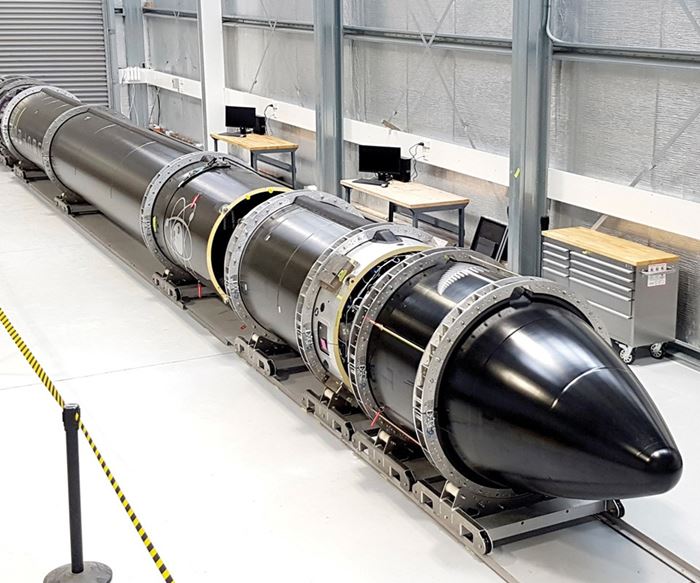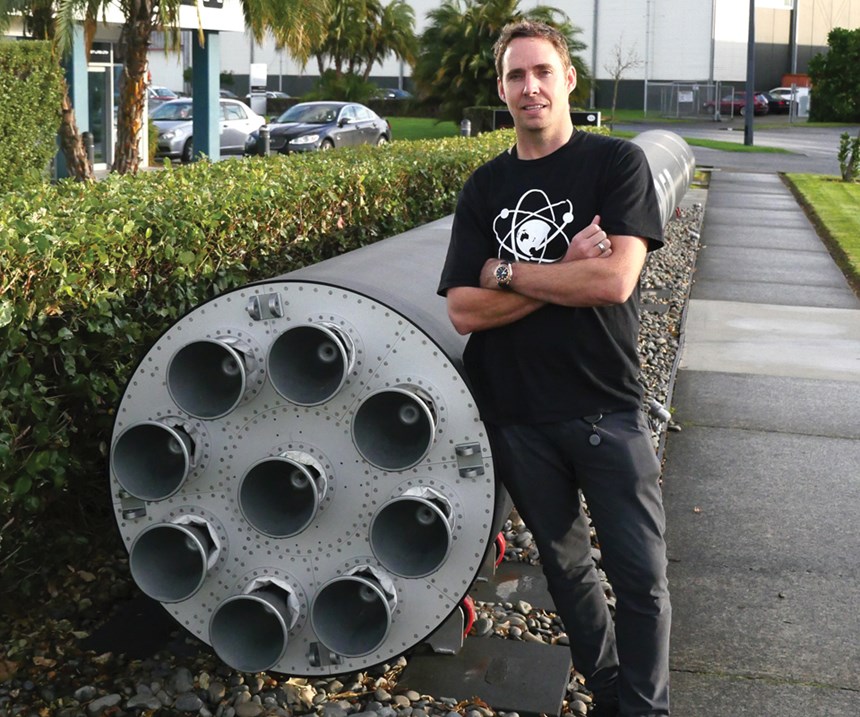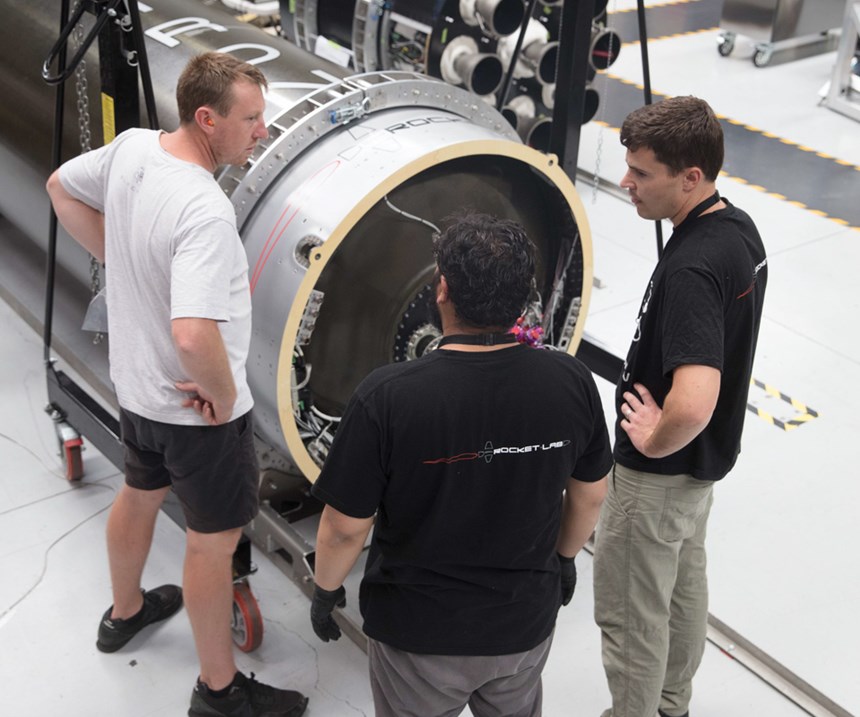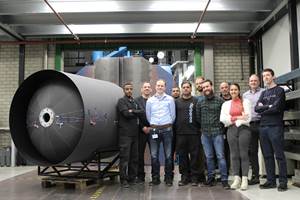Rocket Lab all-composite Electron launch vehicle
New player scaling up two-stage rocket to relieve small-satellite launch backlog.
There is a growing backlog of grounded satellites waiting to fly into orbit and get to work. Most of them are small satellites (SmallSats) and very small CubeSats (see the Side Story below). But in position in low Earth orbit (LEO), they will help provide sizeable services, such as affordable Internet, live Earth observation for activities that include environmental monitoring, natural disaster prediction, search-and-rescue services, and up-to-date maritime data.
The missing piece is transport into that LEO. Currently, SmallSats and CubeSats must wait for space-available piggyback slots on high-powered rockets operated by major commercial players, such as United Launch Alliance (ULA, Centennial, CO) and SpaceX (Hawthorne, CA, US) in the US, or on European and Japanese launch vehicles, among others (see Learn More, p. 29). Piggyback launches often deliver these satellites to the International Space Station (ISS, altitude 420 km) first, where they are subsequently deployed by services such as NanoRacks (Washington, DC, US) to their destined orbit (see “The emerging commercial space industry”).
“Companies are currently facing long waits, often years, to get their satellites on orbit,” claims New Zealander Peter Beck, CEO of Rocket Lab — a private company founded by Beck in 2006, with administrative, design and manufacturing operations located in Auckland, NZ, and in Huntington Beach, CA, US.
One among several commercial companies that have taken aim at this market, Rocket Lab has committed to a faster solution.
Mission: CubeSats to LEO
Beck defines Rocket Lab’s mission as one that will “remove the barriers to commercial space by providing frequent launch opportunities to low Earth orbit.” The company will offer orbital launches on its own Electron rocket from its own launch site on New Zealand’s Mahia Peninsula.
In October 2015, the National Aeronautics and Space Admin. (NASA, Washington, DC, US) awarded Rocket Lab a Venture Class Launch Services contract, valued at US$6.95 million, for demonstration CubeSat launches to LEO on an Electron rocket. Provided with additional funding from Lockheed Martin (Bethesda, MD, US) and other sources, Rocket Lab was recently valued at more than US$1 billion.
Notably, Rocket Lab advertises dedicated (single-customer) launches at ~US$5 million — compared to a reported US$62 million for SpaceX’s Falcon 9 — and promises either a dedicated delivery “when and where required” or a rideshare service. Although ULA’s Vulcan new-generation launch vehicle is projected to lift up to 20 MT to LEO in payload fairings 5.4m diameter and up to 26.5 m length, the 17m high, 1.2m diameter Electron is designed to lift a nominal payload of 150 kg (maximum 225 kg) to a 500-km sun-synchronous LEO. (In a sun-synchronous orbit, the satellite passes over the same part of the Earth at roughly the same local time each day.) The difference in size, power requirements and payload capacity, and the relative simplicity of Electron — its launch components are not reusable, so it does not need the high sophistication required of a system that must return to earth, refuel, and relaunch multiple times — make it an appealing bargain for small satellite launches.
Customers signed up to ride Electron so far include NASA, Planet Labs (Planet, San Francisco, CA, US); Spire (San Francisco, CA, US); and Moon Express (Cape Canaveral, FL, US), which has contracted for three launches of its MX-1 spacecraft to the Moon, including its Google Lunar XPRIZE shot (see “Google shoots the moon”). Payloads can be integrated at the launch site, following standard practice, or customers can choose to pack their satellites into a Plug-in Payload module in their own facilities, and then send the packed module back to Rocket Lab for integration with the Electron vehicle.
Rapid, frequent deployment
Rocket Lab’s mission focuses on rapid deployment of small payloads and plans to achieve its mission through several strategic actions: First, its private launch facilities are located in a remote, underpopulated area of New Zealand. This removes launch activity from sites in crowded, more densely populated locales (e.g., Houston and Florida), thus allowing more frequent launches. “The remote location of the site, particularly its low volume of air and marine traffic, is a key factor in enabling unprecedented access to space, which is part of Rocket Lab’s mission,”
Beck says.
Further, its Electron rocket and Rutherford engines are designed for rapid scale-up of production, including vertical integration of advanced composite materials and advanced manufacturing processes. “Rocket Lab has designed Electron to provide launches at exceptional frequency,” Beck explains. “This, in our view, is what will change how we use and understand space. At full production, we expect to launch more than 50 times a year, and we’re regulated to launch up to 120 times a year. In comparison,” he notes, from all sources, “there were 22 launches last year from the United States, and 82 internationally.” Production in Huntington Beach and Auckland is followed by assembly in Auckland and launches, primarily, in New Zealand.
Although Rocket Lab was unwilling to identify proprietary materials and manufacturing processes, CW learned that carbon fiber composites were selected for all of Electron’s primary structures, including the payload fairing. “We worked to ensure commonality between the structures in both stages of the rocket to allow rapid production at scale,” says composites team manager Ben Malcolm.
A key to its rapid scale-up strategy was the use of additive manufacturing for the Rutherford rocket engines. Nine are used for the first stage of Electron, and one for its second stage. “The rocket engines are printed using titanium and super alloys. We use groundbreaking 3D printing techniques to rapidly print rocket engines, and are able to produce a rocket engine in a matter of days,” Beck says. “3D printing also enabled us to rapidly iterate during our research and development phase and create an engine that would have been impossible to produce using traditional manufacturing techniques.”
Although no composite parts are 3D-printed, the Rutherford engines are powered by oxygen/kerosene fuel, and Rocket Lab revealed that it has developed carbon fiber composite tanks that are compatible with the liquid oxygen component.
Near perfect first launch
The first Electron test launch, appropriately named It’s a Test, lifted off May 25, 2017, from the Mahia Peninsula launch site. Although Electron reached space, it was unable to fulfill its goal of entering orbit. Beck nevertheless considers it a “hugely successful first test launch [with a] great first stage burn, stage separation, second stage ignition and fairing separation — all of the key, and generally most challenging, events. “We’re committed to making space accessible and the test was a phenomenal milestone in that journey.” That was confirmed in August when Rocket Lab completed an internal review that “found the launch had to be terminated due to an independent contractor’s ground equipment issue, rather than an issue with the rocket. Rocket Lab’s investigative board has identified the root causes and corrective actions.” At CW presstime, another launch vehicle was expected to be ready for launch in mid-October, and after that, Rocket Lab would launch when ready.
Related Content
Composite molding compound replaces Invar for lightweight small satellite structures
Patz Materials and Technologies and Lawrence Livermore National Laboratory developed a new monolithic optics housing with 80% less weight, near-zero CTE and the high-volume manufacturing required for commercial space.
Read MoreAirborne delivers composite upper stage tank for EU ENVOL project
Nine-member consortium targets development of low-cost, green vertical orbital launcher with manufacture of an ultra-lightweight composite tank design in an automated manufacturing environment.
Read MoreHigh-temperature composite 3D printing facilitates design, manufacture of deployable space structures
Opterus R&D employs an AON3D printer and OOA prepregs to build the tooling, prototypes and end-use versions of its foldable CFRP satellite structures.
Read MoreOrbital Composites wins award from U.S. Space Force to build space factories for antennas
Partners Axiom Space, Northrop Grumman Space Logistics and Southwest Research Institute will help advance ISAM technologies for kilometer-scale LEO antennas, space stations and GEO applications, targeting space factory in 3-5 years.
Read MoreRead Next
Plant tour: Daher Shap’in TechCenter and composites production plant, Saint-Aignan-de-Grandlieu, France
Co-located R&D and production advance OOA thermosets, thermoplastics, welding, recycling and digital technologies for faster processing and certification of lighter, more sustainable composites.
Read MoreVIDEO: High-volume processing for fiberglass components
Cannon Ergos, a company specializing in high-ton presses and equipment for composites fabrication and plastics processing, displayed automotive and industrial components at CAMX 2024.
Read MoreAll-recycled, needle-punched nonwoven CFRP slashes carbon footprint of Formula 2 seat
Dallara and Tenowo collaborate to produce a race-ready Formula 2 seat using recycled carbon fiber, reducing CO2 emissions by 97.5% compared to virgin materials.
Read More


























